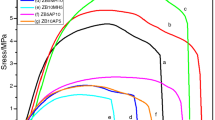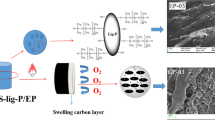Abstract
The effect of zinc bisdiethylphosphinate (ZnPi) and organoclay on mechanical, thermal, and flame retardant properties of poly(ethylene terephthalate) (PET) fiber was investigated. ZnPi was preferred due to its fusible character at spinning temperature and organoclay was used for synergistic interaction. The mechanical, thermal, and flame retardant properties of fibers were examined by tensile testing, thermogravimetric analysis (TG), and micro combustion calorimeter (MCC). The tensile strength of the PET fiber reduced with the addition of both ZnPi and organoclay. The TG results showed that the inclusion of ZnPi increased the char residue. The MCC results showed that the addition of organoclay increased the barrier effect of formed char which depends on char amount, thickness, and integrity and reduces the maximum heat evolved during the test. This result was also important in terms of showing that the organoclay was effective in thermally thin samples.





Similar content being viewed by others
References
Mclntyre JE. Synthetic fibers: nylon, polyester, acrylic, polyolefin. Cambridge: CRC Press; 2000.
Lewin M. Handbook of fiber chemistry. New York: CRC Press; 2007.
Weil ED, Levchik SV. Flame retardants for plastics and textiles. Munich: Hanser Publications; 2009.
Levchik SV, Weil ED. Flame redardancy of thermoplastic polyesters—a review of the recent literature. Polym Int. 2005;54:11–35.
Zhang S, Horrocks AR. A review of flame retardant polypropylene fibres. Prog Polym Sci. 2003;28:1517–38.
Horrocks AR, Kandola BK, Davies PJ, Zhang S, Padbury SA. Developments in flame retardant textiles—a review. Polym Degrad Stab. 2005;88:3–12.
Morgan AB, Wilkie CA. Flame retardant polymer nanocomposites. Hoboken: Wiley; 2007.
Kiliaris P, Papaspyrides CD. Polymer/layered silicate (clay) nanocomposites: an overview of flame retardancy. Prog Polym Sci. 2010;35:902–58.
Samyn F, Bourbigot S, Jama C, Bellayer S. Fire retardancy of polymer clay nanocomposites. Is there an influence of the nanomorphology? Polym Degrad Stab. 2008;93:2019–24.
Bourbigot S, Duquesne S, Jama C. Polymer nanocomposites: how to reach low flammability. Macromol Symp. 2006;233:180–90.
Morgan AB, Wilkie CA. Flame retardant polymer nanocomposites. New York: CRC Press; 2010.
Erdem N, Cireli AA, Erdogan UH. Flame retardancy behaviors and structural properties of polypropylene/nano-SiO2 composite textile filaments. J Appl Polym Sci. 2009;111:2085–91.
Vargas AF, Orozco VH, Rault F, Giraud S, Devaux E, Lopez BL. Influence of fiber-like nanofillers on the rheological, mechanical, thermal and fire properties of polypropylene: an application to multifilament yarn. Compos Part A. 2010;41:1797–806.
Horrocks AR, Kandola BK, Smart G, Zhang S, Hull TR. Polypropylene fibers containing dispersed clays having improved fire performance. I. Effect of nanoclays on processing parameters and fiber properties. J Appl Polym Sci. 2007;106:1707–17.
Rault F, Pleyber E, Campagne C, Rochery M, Giraud S, Bourbigot S, Devaux E. Effect of manganese nanoparticles on the mechanical, thermal and fire properties of polypropylene multifilament yarn. Polym Degrad Stab. 2009;94:955–64.
Rault F, Campagne C, Rochery M, Giraud S, Devaux E. Polypropylene multifilament yarn filled with clay and/or graphite: study of a potential synergy. J Polym Sci Part B Polym Phys. 2010;48:1185–95.
Shanmuganathan K, Deodhar S, Dembsey NA, Fan Q, Patra PK. Condensed-phase flame retardation in nylon 6-layered silicate nanocomposites: films, fibers, and fabrics. Polym Eng Sci. 2008;48:662–75.
Bourbigot S, Devaux E, Flambard X. Flammability of polyamide-6/clay hybrid nanocomposite textiles. Polym Degrad Stab. 2002;75:397–402.
Salaün F, Lewandowski M, Vroman I, Bedek G, Bourbigot S. Development and characterization of flame retardant fibres from isotactic polypropylene melt compounded with melamine formaldehyde microcapsules. Polym Degrad Stab. 2011;96:131–43.
Smart G, Kandola BK, Horrocks AR, Nazare S, Marney D. Polypropylene fibers containing dispersed clays having improved fire performance. Part II. Characterization of fibers and fabrics from PP-nanoclay blends. Polym Adv Technol. 2008;19:658–70.
Alongi J. Investigation on flame retardancy of poly(ethylene terephthalate) for plastics and textiles by combination of an organo-modified sepiolite and Zn phosphinate. Fiber Polym. 2011;12:166–73.
Yi J, Yin H, Cai X. Effects of common synergistic agents on intumescent flameretardant polypropylene with a novel charring agent. J Therm Anal Calorim. 2012. doi:10.1007/s10973-012-2211-z.
Xu T, Zhong Y, Liu Y, Yu H, Mao Z. Flammability properties of PI fabric coated with montmorillonite. J Therm Anal Calorim. 2012. doi:10.1007/s10973-012-2549-2.
Levchik SV, Weil ED. A review of recent progress in phosphorus-based flame retardants. J Fire Sci. 2006;24:345–64.
Braun U, Schartel B. Flame retardancy mechanisms of aluminium phosphinate in combination with melamine cyanurate in glass-fibre-reinforced poly(1,4-butylene terephthalate). Macromol Mater Eng. 2008;293:206–17.
Isıtman NA, Gunduz HO, Kaynak C. Nanoclay synergy in flame retarded/glass fibre reinforced polyamide 6. Polym Degrad Stab. 2009;94:2241–50.
Braun U, Schartel B, Fichera MA, Jager C. Flame retardancy mechanisms of aluminium phosphinate in combination with melamine cyanurate and zinc borate in glass-fibre-reinforced polyamide 6,6. Polym Degrad Stab. 2007;92:1528–45.
Vannier A, Duquesne S, Bourbigot S, Alongi J, Camino G, Delobel R. Investigation of the thermal degradation of PET, zinc phosphinate, OMPOSS and their blends—identification of the formed species. Polym Degrad Stab. 2009;495:155–66.
Lyon RE, Walters RN, Stoliarov SI. Screening flame retardants for plastics using microscale combustion calorimetry. Polym Eng Sci. 2007;47:1501–10.
Yang CA, He Q, Lyon RE, Hu Y. Investigation of the flammability of different textile fabrics using microscale combustion calorimetry. Polym Degrad Stab. 2010;95:108–15.
Nagano Y, Sugimoto Y. Micro combustion calorimetry aiming at 1 mg samples. J Therm Anal Calorim. 1999;57:867–74.
Morgan AB, Galaska M. Microcombustion calorimetry as a tool for screening flame retardancy in epoxy. Polym Adv Technol. 2008;19:530–46.
Xie W, Gao Z, Pan W, Hunter D, Singh A, Vaia R. Thermal degradation chemistry of alkyl quaternary ammonium montmorillonite. Chem Mater. 2001;13:2979–90.
Author information
Authors and Affiliations
Corresponding author
Rights and permissions
About this article
Cite this article
Doğan, M., Erdoğan, S. & Bayramlı, E. Mechanical, thermal, and fire retardant properties of poly(ethylene terephthalate) fiber containing zinc phosphinate and organo-modified clay. J Therm Anal Calorim 112, 871–876 (2013). https://doi.org/10.1007/s10973-012-2682-y
Received:
Accepted:
Published:
Issue Date:
DOI: https://doi.org/10.1007/s10973-012-2682-y




